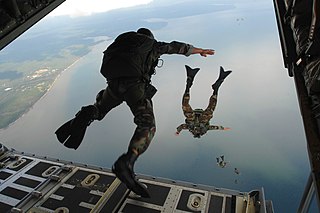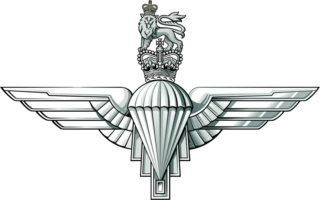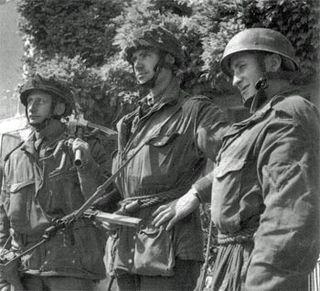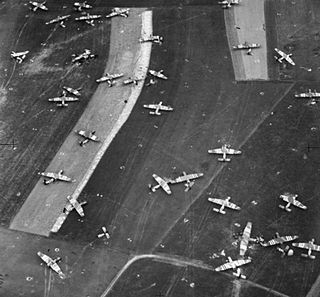Related Research Articles

A paratrooper or military parachutist is a soldier trained to conduct military operations by parachuting directly into an area of operations, usually as part of a large airborne forces unit. Traditionally paratroopers fight only as light infantry armed with small arms and light weapons, although some paratroopers can also function as artillerymen or mechanized infantry by utilizing field guns, infantry fighting vehicles and light tanks that are airdropped together into the combat zone.

Airborne forces are ground combat units carried by aircraft and airdropped into battle zones, typically by parachute drop. Parachute-qualified infantry and support personnel serving in airborne units are also known as paratroopers.

Operation Tonga was the codename given to the airborne operation undertaken by the British 6th Airborne Division between 5 June and 7 June 1944 as a part of Operation Overlord and the D-Day landings during the Second World War.

Pegasus Bridge, originally called the Bénouville Bridge after the neighbouring village, is a road crossing over the Caen Canal, between Caen and Ouistreham in Normandy. The original bridge, built in 1934, is now a war memorial and is the centrepiece of the Memorial Pegasus museum at nearby Ranville. It was replaced in 1994 by a modern design which, like the old one, is a bascule bridge.

The Parachute Regiment, colloquially known as the Paras, is the airborne and elite infantry regiment of the British Army. The first battalion is part of the Special Forces Support Group under the operational command of the Director Special Forces. The other battalions are the parachute infantry component of the British Army's rapid response formation, 16 Air Assault Brigade. The Paras, along with the Guards, are the only line infantry regiment of the British Army that has not been amalgamated with another unit since the end of the Second World War.

Bénouville is a commune in the Calvados department in the Normandy region in northwestern France.

General Sir Richard Nelson "Windy" Gale, was a senior officer in the British Army who served in both world wars. In the First World War he was awarded the Military Cross in 1918 whilst serving as a junior officer in the Machine Gun Corps. During the Second World War he served with 1st Parachute Brigade and then the 6th Airborne Division during the D-Day landings and Operation Tonga in 1944. After the end of the conflict, Gale remained in the army and eventually, in 1958, succeeded Field Marshal The Viscount Montgomery as Deputy Supreme Allied Commander Europe.

Major Reginald John Howard DSO was a British Army officer who led a glider-borne assault that captured the Caen canal and Orne river bridges on 6 June 1944, as part of the D-Day landings during the Second World War. These bridges spanned the Caen Canal and the adjacent River Orne, and were vitally important to the success of the D-Day landings. Since the war, the bridge over the canal has become known as "Pegasus Bridge," a tribute to the men who captured it. The bridge over the River Orne later became known as Horsa Bridge after the Horsa gliders that carried troops to the bridges.

Lieutenant Herbert Denham Brotheridge was a British Army officer who served with the 2nd Battalion, Oxfordshire and Buckinghamshire Light Infantry during the Second World War. He is often considered to be the first Allied soldier to be killed in action on D-Day, 6 June 1944. He was killed during Operation Tonga: the British airborne landings which secured the left flank of the invasion area before the main assault on the Normandy beaches began.

The 5th Parachute Brigade was an airborne forces formation of brigade strength, raised by the British Army during the Second World War. Created during 1943, the brigade was assigned to the 6th Airborne Division, serving alongside the 3rd Parachute Brigade and the 6th Airlanding Brigade.

Brigadier Alastair "Jock" Stevenson Pearson, was a baker, farmer and one of the most highly regarded soldiers of the Parachute Regiment and the British Army who served in the Second World War.

The 6th Airlanding Brigade was an airborne infantry brigade of the British Army during the Second World War. Created during May 1943, the brigade was composed of three glider infantry battalions and supporting units, and was assigned to the 6th Airborne Division, alongside the 3rd and 5th Parachute Brigades.
Colonel Henry John Sweeney MC, known as Tod Sweeney, was an officer of the British Army. During the Second World War he was a platoon commander in the coup de main operation, by gliderborne troops of the 2nd Battalion, Oxfordshire and Buckinghamshire Light Infantry, on D-Day, 6 June 1944, tasked to seize Horsa Bridge and Pegasus Bridge before the main assault on the Normandy beaches began. The following day he was awarded the Military Cross for rescuing a wounded member of his platoon while under heavy fire near Escoville. Sweeney commanded the 1st Green Jackets at Penang from April 1962 to January 1964; during the Brunei Revolt and Indonesia-Malaysia confrontation.
Colonel David James Wood MBE was the last surviving officer of the coup de main operation carried out by glider borne troops of the 2nd Oxfordshire and Buckinghamshire Light Infantry, on D Day, 6 June 1944, tasked with capturing Pegasus Bridge and Horsa Bridge before the main assault on the Normandy beaches began.

Operation Mallard was the codename for an airborne forces operation, which was conducted by the British Army on 6 June 1944, as part of the Normandy landings during the Second World War.

The capture of the Caen canal and Orne river bridges was an operation by airborne forces of the British Army that took place in the early hours of 6 June 1944 as part of the Normandy landings of the Second World War. The objective was to capture intact two road bridges in Normandy across the River Orne and the Caen canal, providing the only exit eastwards for British forces from their landing on Sword Beach. Intelligence reports said both bridges were heavily defended by the Germans and wired for demolition. Once captured, the bridges had to be held against any counter-attack, until the assault force was relieved by commandos and other infantry advancing from the landing beach.

The 7th Parachute Battalion was an airborne infantry battalion of the Parachute Regiment, formed by the British Army during the Second World War. The battalion was raised in November 1942 by the conversion of the 10th Battalion, Somerset Light Infantry to parachute duties. It was initially assigned to the 3rd Parachute Brigade, part of 1st Airborne Division, but moved to the 5th Parachute Brigade, alongside the 12th and 13th Parachute battalions, of the 6th Airborne Division soon afterwards.

The 8th (Midlands) Parachute Battalion was an airborne infantry battalion of the Parachute Regiment, raised by the British Army during the Second World War. The battalion was created in late 1942 by the conversion of the 13th Battalion, Royal Warwickshire Regiment to parachute duties. The battalion was assigned to the 3rd Parachute Brigade, serving alongside the 7th and 9th Parachute battalions, in the 1st Airborne Division before being reassigned to help form the 6th Airborne Division in May 1943.

The 13th (Lancashire) Parachute Battalion was an airborne infantry battalion of the Parachute Regiment, raised by the British Army during the Second World War. The battalion was formed in May 1943 by the conversion of the 2/4th Battalion, South Lancashire Regiment to parachute duties and was assigned to the 5th Parachute Brigade in the 6th Airborne Division.
References
- ↑ "coup de main". dictionary.com . Retrieved 10 January 2024.
- ↑ "coup de main - English translation". Linguee . Retrieved 10 January 2024.
- ↑ "Coup de Main". DOD Dictionary of Military and Associated Terms . Archived from the original on 2016-03-03.
- ↑ Académie française (1765). Dictionnaire de l'Académie françoise. Chez les Libraires associés. p. 291.
- ↑ Perry, Mike (9 December 2012). "Operation Tonga". SOFREP. Retrieved 15 August 2021.
- ↑ Fowler, Will (2010). Pegasus Bridge: Bénouville, D-Day 1944. Oxford: Osprey. ISBN 9781846038488.
- ↑ White, Kristopher D. (9 January 2018). "Bloody Horror of Upton's Charge". American Battlefield Trust.